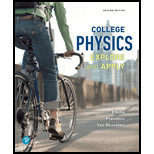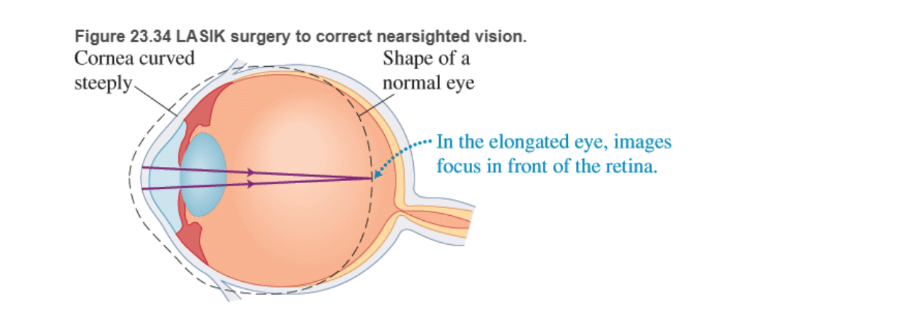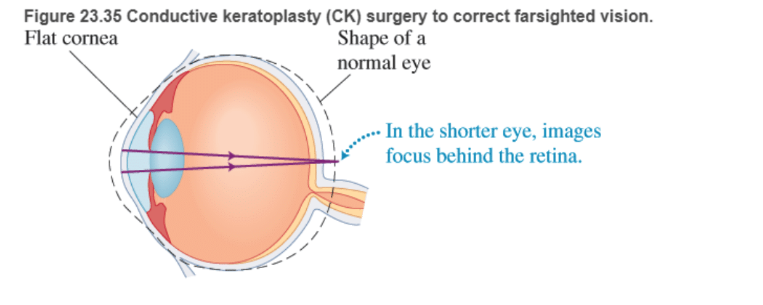
Concept explainers
BIO Laser surgery for the eye LASIK (laser-assisted in situ keratomileusis) is a surgical procedure intended to reduce a person's dependency on glasses or contact lenses. Laser eye surgery corrects common vision problems, such as myopia (nearsightedness), hyperopia (farsightedness), astigmatism (blurred vision resulting from corneal irregularities), or some combination of these. In myopia, the cornea, the clear covering at the front of the eye, is often too highly curved, causing rays from distant objects to form sharp images in front of the retina (Figure 23.34). LASIK refractive surgery can flatten the cornea so that images of distant objects form on the retina. A knife cuts a flap in the cornea with a hinge left at one end of this flap. The flap is folded back, exposing the middle section of the cornea. Pulses from a computer-controlled laser vaporize a portion of the tissue and the flap is replaced.

In farsighted people, an object held at the normal near point of the eye (about 25-50 cm from the eye) forms an image behind the retina (Figure 23.35 Increasing the curvature of the cornea causes rays from near objects to produce an image on the retina

What is one surgical way to correct nearsighted vision?
a. Reduce the radius of curvature of the cornea, thus reducing the focal length of the eye's optics system.
b. Increase the radius of curvature of the cornea, thus increasing the focal length of the eye's optics system.
c. Increase the iris opening to allow more light to enter.
d. Use the ciliary muscle to increase the thickness of the lens.
Want to see the full answer?
Check out a sample textbook solution
Chapter 23 Solutions
EBK COLLEGE PHYSICS
Additional Science Textbook Solutions
Genetic Analysis: An Integrated Approach (3rd Edition)
Chemistry: Structure and Properties (2nd Edition)
Microbiology: An Introduction
Campbell Biology (11th Edition)
Microbiology: An Introduction
Organic Chemistry (8th Edition)
- RT = 4.7E-30 18V IT = 2.3E-3A+ 12 38Ω ли 56Ω ли r5 27Ω ли r3 28Ω r4 > 75Ω r6 600 0.343V 75.8A Now figure out how much current in going through the r4 resistor. |4 = unit And then use that current to find the voltage drop across the r resistor. V4 = unitarrow_forward7 Find the volume inside the cone z² = x²+y², above the (x, y) plane, and between the spheres x²+y²+z² = 1 and x² + y²+z² = 4. Hint: use spherical polar coordinates.arrow_forwardганм Two long, straight wires are oriented perpendicular to the page, as shown in the figure(Figure 1). The current in one wire is I₁ = 3.0 A, pointing into the page, and the current in the other wire is 12 4.0 A, pointing out of the page. = Find the magnitude and direction of the net magnetic field at point P. Express your answer using two significant figures. VO ΜΕ ΑΣΦ ? Figure P 5.0 cm 5.0 cm ₁ = 3.0 A 12 = 4.0 A B: μΤ You have already submitted this answer. Enter a new answer. No credit lost. Try again. Submit Previous Answers Request Answer 1 of 1 Part B X Express your answer using two significant figures. ΜΕ ΑΣΦ 0 = 0 ? below the dashed line to the right P You have already submitted this answer. Enter a new answer. No credit lost. Try again.arrow_forward
 Principles of Physics: A Calculus-Based TextPhysicsISBN:9781133104261Author:Raymond A. Serway, John W. JewettPublisher:Cengage Learning
Principles of Physics: A Calculus-Based TextPhysicsISBN:9781133104261Author:Raymond A. Serway, John W. JewettPublisher:Cengage Learning University Physics Volume 3PhysicsISBN:9781938168185Author:William Moebs, Jeff SannyPublisher:OpenStax
University Physics Volume 3PhysicsISBN:9781938168185Author:William Moebs, Jeff SannyPublisher:OpenStax Glencoe Physics: Principles and Problems, Student...PhysicsISBN:9780078807213Author:Paul W. ZitzewitzPublisher:Glencoe/McGraw-Hill
Glencoe Physics: Principles and Problems, Student...PhysicsISBN:9780078807213Author:Paul W. ZitzewitzPublisher:Glencoe/McGraw-Hill Physics for Scientists and Engineers: Foundations...PhysicsISBN:9781133939146Author:Katz, Debora M.Publisher:Cengage Learning
Physics for Scientists and Engineers: Foundations...PhysicsISBN:9781133939146Author:Katz, Debora M.Publisher:Cengage Learning Physics for Scientists and Engineers, Technology ...PhysicsISBN:9781305116399Author:Raymond A. Serway, John W. JewettPublisher:Cengage Learning
Physics for Scientists and Engineers, Technology ...PhysicsISBN:9781305116399Author:Raymond A. Serway, John W. JewettPublisher:Cengage Learning College PhysicsPhysicsISBN:9781305952300Author:Raymond A. Serway, Chris VuillePublisher:Cengage Learning
College PhysicsPhysicsISBN:9781305952300Author:Raymond A. Serway, Chris VuillePublisher:Cengage Learning





